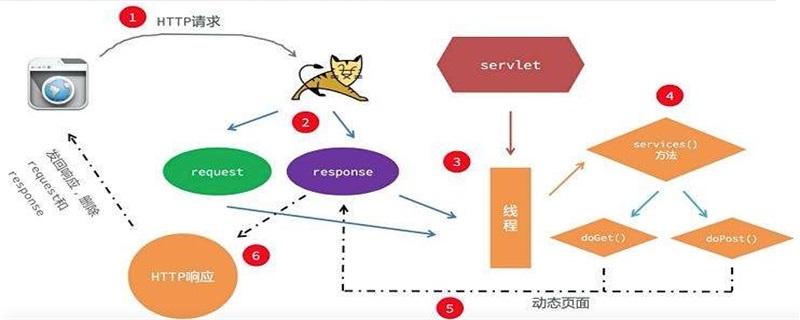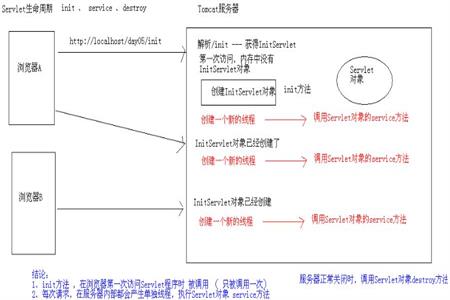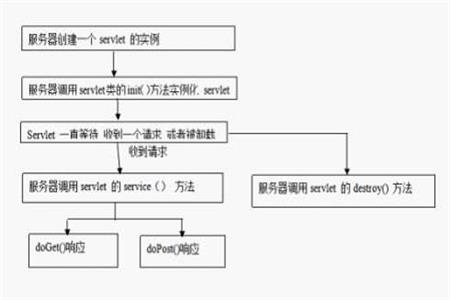
The four stages of the Servlet life cycle are: loading stage, initialization stage, request processing and destruction stage. The methods to control the Servlet object life cycle are: init(), service() and destroy ()
The entire life cycle of Servlet is managed by the Servlet container, which uses the javax.servlet.Servlet interface to understand and manage Servlet objects. The life cycle of Servlet can be divided into four stages. They are: loading phase, initialization phase, request processing and destruction phase, so in the following article, I will introduce each stage of the Servlet object life cycle in detail
[Recommended course:Java Course】

Life cycle of Servlet
1. Load Servlet
The first stage of the Servlet life cycle is to load and initialize through the Servlet container
The Servlet container loads everything Actions performed:
(1) Load Servlet class
(2) Create Servlet and instantiate
Note: If the Servlet is not in the previous stage, it may be lazy loaded process, because you need to know that the web container determines that a Servlet is needed to request services.
2. Initialization phase
After the Servlet is instantiated successfully, the Servlet container begins to initialize the Servlet object and immediately calls the Servlet.init() method to initialize resources
Servlet.init(ServletConfig)
If the Servlet cannot be initialized during this process, it will notify the Servlet container through ServletException or UnavailableException that it cannot be initialized
3. Process the request
After initialization, the Servlet instance is ready to serve client requests. When the Servlet instance is in the service request, the Servlet container will perform the following operations
(1) It will create ServletRequest and ServletResponse objects. If an HTTP request is sent, the Web container will create HttpServletRequest and HttpServletResponse objects
(2) After creating the request and response objects, it will call the Servlet.service() method.
Servlet.service(ServletRequest,ServletResponse)
The service() method when processing the request may throw ServletException or UnavailableException
4. Destroy the Servlet
When the Servlet container destroys the Servlet , it performs the following operations,
(1) It allows all threads currently running in the Servlet instance to be released after completing their jobs.
(2) After the currently running thread completes its job, the Servlet container releases all references to the entire servlet object instantiated by calling the destroy() method

Servlet life cycle method
Method used to control the servlet life cycle, it has three life cycle methods:
init() method
Whether the Servlet object has been successfully initialized, it is called by the Servlet container. This method only accepts one parameter, the ServletConfig object
public void init(ServletConfig con)throws ServletException{ }service() method
Used to notify the Servlet object of the information requested by the client. It is the most important execution method and provides a connection between the client and the server. The web server handles the client's request and sends the response back to the client by calling the service() method.
public void service(ServletRequest req, ServletResponse resp)
throws ServletException, IOException { }This method accepts two parameters:
ServletRequest: Indicates collecting the data requested by the client.
ServletResponse: Indicates the generated output content.
destroy() method
This method only runs once in the servlet's life cycle and is called at the end of the servlet's life cycle. Indicates the end of Servlet object instantiation. Once this method is activated,
means that all Servlet instances will be released
public void destroy()

Summary: That’s it for this article The entire content of the article is here, I hope it will be helpful for everyone to learn the Servlet cycle
The above is the detailed content of What are the stages of the Servlet life cycle?. For more information, please follow other related articles on the PHP Chinese website!
 servlet life cycle
servlet life cycle
 unicode encoding conversion
unicode encoding conversion
 How to check the video memory of Win11
How to check the video memory of Win11
 How much is Dimensity 9000 equivalent to Snapdragon?
How much is Dimensity 9000 equivalent to Snapdragon?
 Ubuntu startup black screen solution
Ubuntu startup black screen solution
 How to check the ftp server address
How to check the ftp server address
 What are the advantages and disadvantages of decentralization
What are the advantages and disadvantages of decentralization
 What are the data backup software?
What are the data backup software?